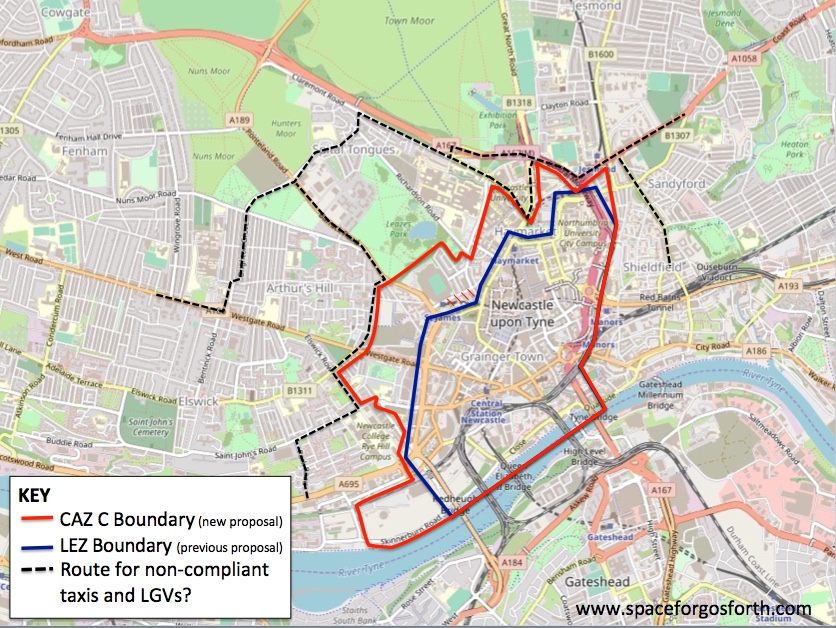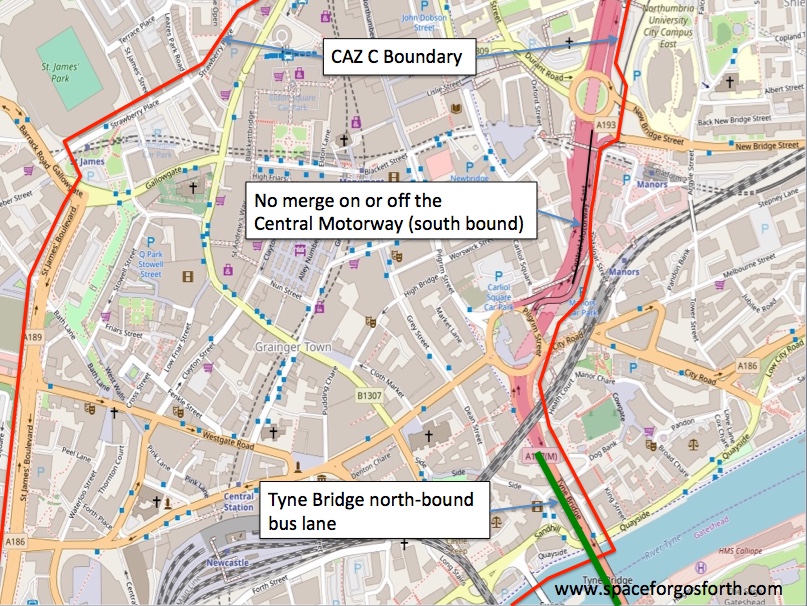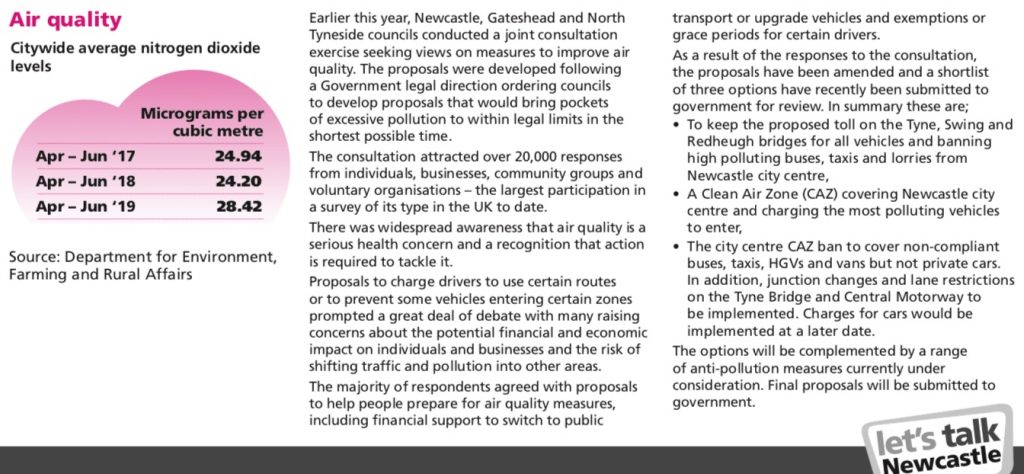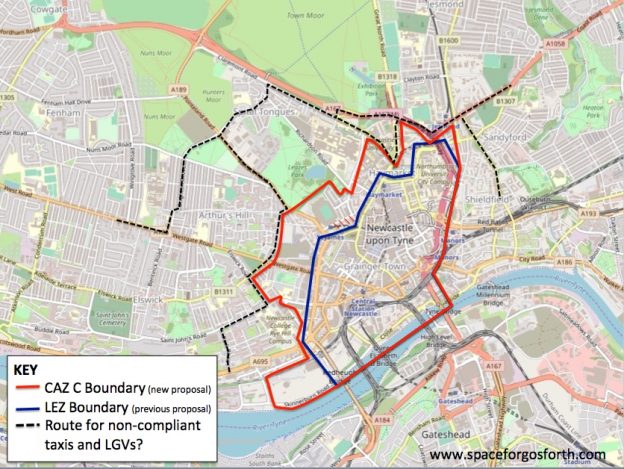Newcastle, North Tyneside and Gateshead Councils have announced their proposed final air quality plan following a consultation in March. The new plan has a smaller Clean Air Zone and no financial disincentive for private cars no matter how polluting they are. This is now subject to a final consultation before submission to Government later this year.
As we have said many times before, this plan must by law (a) achieve air quality limits in the shortest possible timescales; (b) reduce exposure as quickly as possible; and (c) ensure compliance is likely rather than just possible.
In this blog we describe the Council’s final (watered-down) plan and why we think it unlikely that these legal tests will be met in full without further measures in addition to those proposed.
Take part in the consultation – until Monday 25 November
The Council particularly wants to hear from bus and taxi companies and businesses that operate within the zone. These are the people and businesses that are both most affected by the charge and most at risk from poor health due to air pollution. As a recent study confirmed, drivers are exposed to the highest levels of harmful air pollution – and taxi drivers are most at risk.
1. What is the Council’s proposed Final Plan?
The main element of the plan is a Charging Clean Air Zone – Class C (CAZ C). This means that any older more polluting lorries, buses, coaches, taxis or vans will have to pay a clean air charge to enter the zone. Private cars, which would be charged in a CAZ D, are not required to pay in a CAZ C.
The zone for the CAZ C is shown in the diagram below. One change has been made from the Low Emission Zone previously consulted on, to expand the zone to include St James park and Strawberry Place. In 2017 illegal levels of air pollution were recorded on Strawberry Place so the new boundary should help reduce pollution here.

In March, the Council’s modelling suggested that neither a CAZ C nor a CAZ D would be sufficient to meet air quality limits. In its more recent modelling, the Council has revised the model inputs to reduce the number of diesel cars compared to petrol cars. This has the effect of reducing the forecast pollution levels as petrol cars emit less nitrogen dioxide than diesels. The Council states this is to reflect a national trend for people buying new cars to buy petrol rather than diesel.
Further changes are planned on the Tyne Bridge and Central Motorway. On the Tyne Bridge the plan is to reduce traffic (and pollution) by only having one general traffic lane in each direction plus a north-bound bus lane. On the Central Motorway it will no longer be possible to merge from the New Bridge Street junction onto the A167 (M) southbound. Anyone travelling south-bound wanting to drive via Swan House roundabout will have to exit at the New Bridge Street junction.

The changes to the Tyne Bridge and Central Motorway replace the previous proposal for tolls on the Tyne bridges.
In addition to the measures to improve air quality, there are also mitigations planned, though these will depend on government funding. These include grants to upgrade vehicles that would be charged if entering the zone, and bus lanes to make journeys by bus quicker and more reliable and offset additional costs due to the charging zone. The Council previous said they were considering Red Routes again although this isn’t mentioned in the consultation.
Further details, including the other options considered, are available on the consultation website and in the report presented to Newcastle City Council Cabinet. Our assessment of the final proposal is below.
2. Has it been established beyond reasonable doubt that the proposed measures will be effective to meet limits in the shortest possible timescales?
This is an important question as the High Court ruled specifically that plans must be likely to achieve air quality limits. This ruling may feel like an obvious point but Newcastle and Gosforth Air Quality Management Areas have had plans since 2010 but air pollution is still substantially worse than the legal limit in both areas because those plans were not effective.
The Council’s plan sets 2021 as the first full year in which limits will be met. If the final plan had been completed on time by December 2018 then potentially compliance could have been brought forward to 2020, but almost certainly it is too late for that now.
In our blog Air Quality – What Works? we reviewed the evidence. Clean Air Zones are generally effective at reducing pollution from the vehicles covered by the CAZ, as are restrictions in traffic volumes such as the lane restrictions proposed on the Tyne Bridge. The CAZ C will also help ensure that buses that have been upgraded stay in Tyneside rather than being moved to other cities as has happened in the past. Council modelling suggests that a CAZ C will be sufficient to meet limits in 2021.
Having a single lane in each direction on the Tyne Bridge will result in longer queues at peak times, but this should reduce pollution where limits are currently not met as there will only be two lanes of traffic rather than four. Based on evidence from elsewhere, not least the Killingworth Road closure, it is also likely that overall traffic levels will reduce as a result.
The Council consultation asks about grace periods for certain types of vehicle. These need to be kept to an absolute minimum so they do not delay meeting limits. Grants to upgrade engines should, on the other hand, speed up the removal of older dirtier engines and, for buses, offset the potential cost of CAZ charges.
There is no independent evidence to support the use of Traffic Management measures such as proposed changes to the Central Motorway or the use of Red Routes. If these changes increase road capacity or encourage more traffic then they could result in more pollution.
3. Will the plan ensure that limits are met in all parts of the City?
The plan is likely to be effective in parts of the city centre where the majority of traffic is buses or taxis.
There are no obvious measures in the plan that would address pollution on the Coast Road or City Road where buses and taxis make up only a small proportion of the traffic. Likewise, we feel it unlikely that the plan will sufficiently address pollution on Gosforth High Street or at Haddricks Mill.
NO₂ at Corner House yesterday (17-10-2019)
24h Average: 77.76 µg/m³
7 Day Average: 84.00 µg/m³ pic.twitter.com/xM7IiVr02R
— Heaton, Corner House, Air Quality (@AirHeaton) October 18, 2019
@AirHeaton: Air Pollution on The Coast Road is consistently worse than the legal limit
We understand that the Councils’ modelling says that limits will now be met at these locations in 2021 because more people will be buying petrol rather than diesel cars. Even if cars are overall producing less nitrogen dioxide though, total pollution could still increase if there are more cars. It was recently reported in the Guardian that emissions had increased since 1990 for exactly this reason despite engines becoming far more efficient and less polluting. Previous assumptions about engine emissions were also proved wrong when it was discovered car manufacturers were installing ‘defeat devices‘ to cheat emissions tests.
At Haddricks Mill we believe counter-measures will be required as the proposed new junction there aims to increase traffic levels, which will add to traffic and air pollution in the surrounding area as well as increased carbon emissions. As we have set out previously the design of the proposed shared foot and cycle ways at Haddricks Mill is also unlikely to encourage many more people to walk or cycle, and there is no additional bus priority planned other than on Killingworth Road.
Even in the city centre, the lack of any restrictions on non-stopping through traffic means the plan is less likely to be effective and will not meet the legal requirement to reduce exposure as quickly as possible. Ghent in Belgium achieved a 20% improvement in air quality by restricting through traffic without any charging. Such an approach could be implemented quickly in Newcastle upon Tyne.
The continued promotion of free parking through Alive After 5 also presents a risk to achieving limits, and may mean that clean air charges for buses, taxis and vans need to be higher to compensate. It is hard to see how retaining this subsidy is consistent with the Council’s secondary objective of a fairer society, especially as bus passengers may face increased costs due to the CAZ C charge.
4. Is the modelling robust and are assumptions justifiable?
The Council needs to address transparently why in its March consultation it stated that neither a CAZ C nor a CAZ D would achieve air quality limits, whereas now it is stating that a CAZ C will be sufficient.
Although it is clear there is a trend nationally away from buying new diesel vehicles, the way this has been applied to the Council’s model could be seen as being suspect, especially since the High Court has ruled that plans must ensure compliance is likely rather than just possible.
More important is what happens to the older diesel vehicles. Potentially this means a glut of older more polluting diesels in the second hand market that could end up in Newcastle because in Newcastle there is currently no plan to restrict these vehicles.
Even if people are buying fewer new diesel cars the total number of diesel cars on the road in the UK is still increasing. This is especially important given the Council has demonstrated cars in Newcastle are on average older and more polluting than the national average.
#AirPollution – There are now 51 million dirty diesel cars on EU roads! Our new analysis shows an increase by 18% over the past 12 months and a 74% rise since 2016. This scandal must stop! https://t.co/kiPZFUVzlI #Dieselgate pic.twitter.com/7SwM1rVYuV
— Transport & Environment (@transenv) September 18, 2019
DEFRA has produced its own predictions for citywide average nitrogen dioxide levels that, if the assumption about cleaner engines was correct, you would expect would be reducing. Instead DEFRA’s figures suggest that citywide average pollution in 2019 will be worse than 2018 and 2017. These figures were published in the September 2019 Cabinet Report, the same meeting where the new Newcastle pollution plans were approved.

The Strategic Case produced in March also said that buses were assumed to have been upgraded (1.9.2) and taxis were modelled as being 100% compliant (1.8.19). This suggests the outputs of the March model were, if anything, likely to be optimistic. The new assumption potentially means even more optimism bias in the model and even without this issue the model is only likely to be accurate +-25%. A target level much lower than the legal limit is needed to ensure that compliance is likely to be achieved.
The one thing the Council must do therefore is to monitor air pollution levels in the run up to 2021 to check and confirm that air quality is improving in line with its predictions. If they are not then additional measures should be put in place for the start of 2021, rather than waiting for 2022 or even 2023 and delaying compliance with limits.
5. Will the Council meet its secondary objectives?
To meet the Council’s secondary objectives relating to health, economy and a fair society we would expect that
- the Council targets pollution levels below that set in law;
- that a principle of ‘polluter pays’ has been applied consistently across all types of vehicle; and
- there would be a very strong focus in the plan on walking and cycling (active travel), as being low cost, non-polluting, widely accessible, effective in supporting the local economy and very beneficial for people’s health.
In the context of transport, improving public health can be best achieved by (a) targeting a lower level of air pollution than set by law and (b) by encouraging more active travel. Economic growth can be best achieved by allowing people to reduce the cost of how they travel e.g. by walking or cycling more, and by prioritising travel modes (walking, cycling and buses) that enable more people to travel in the limited space available in the city. A transport network that prioritises people rather than vehicles, and applies the ‘polluter pays’ principle would also result in a fairer society.
Choosing to use a CAZ C rather than a CAZ D could be seen as undermining the Council’s own objectives as well as making the plan overall less effective. In the Strategic Case (1.4.29) the Council stated that there was “evidence illustrating that in most cases it is private cars that are causing more pollution.” It also feels likely that the issues identified by the Council that led it to reject a CAZ D could be mitigated by setting a charge in the region of £1-£5 for cars rather than £12.50 per day.
The Council’s model outputs, that a CAZ C would mean fewer green house gas emissions compared to a CAZ D, potentially suggests some sort of problem either with the modelling or with the scenarios modelled. In the CAZ D model outputs the Council reported significant rerouting of traffic whereas in practice this is rarely as bad as predicted because of a phenomena called disappearing traffic. While it is perhaps too late to rectify this for the air pollution plan, the Council will need to look at this more closely in the context of its separate commitments on Climate Change.
Improvements for walking and cycling could also be achieved quickly and cheaply by restricting through traffic in residential areas, especially in Gosforth where pollution levels are high and where, unlike other areas of the city, residential streets are still used as if they are main routes for through traffic. Likewise, changes could be made quickly to local destinations like Gosforth High Street using temporary bolt-down kerbs to create protected cycle facilities that enable a much wider range of people to cycle than are currently able. SPACE for Gosforth’s response to the March consultation contained specific proposals to achieve this and reduce pollution in the Gosforth area.
6. Conclusion
Our conclusions from looking at the Council’s plan are as follows.
- That the Council’s plans will reduce pollution levels but with a significant risk that pollution will still be at illegal levels in 2021, even with the CAZ C.
- The Council needs to expedite the measures it has proposed but in parallel continue to model other options, for example closing through routes in the city centre.
- The Council should actively monitor pollution measurements over 2020 to determine if air pollution is reducing in line with its forecasts, and if not the Council should introduce further measures to ensure compliance in 2021.
- We do not believe the Council plan reduces exposure as quickly as possible because none of the main measures will be implemented before 2021. The SPACE for Gosforth response set out a range of measures that could all be implemented before then and which would be effective in reducing air pollution prior to 2021.
- The Council could achieve its secondary objectives of health, economy and a fair society if the plan included measures to enable and encourage more walking and cycling. The plan, as it stands, does not do that. The Council could, for example, implement low traffic neighbourhoods, which are proven to increase walking and cycling, very quickly and cheaply if it wished to do so.
Take part in the consultation – until Monday 25 November
Please do mention in Section 3 of the survey anything that would help you walk, cycle or take the bus more rather than driving, such as less traffic in residential areas.
Links to the SPACE for Gosforth Air Quality Consultation Response
Breathe – A review of the Council’s proposals
Breathe – In the City – SPACE for Gosforth proposals for the City Centre AQMA
Breathe – In Gosforth – SPACE for Gosforth proposals for Gosforth AQMA
Breathe – Implementation – SPACE for Gosforth proposals for how to Implement the Air Quality Plan.
Air Quality – What Works? – SPACE for Gosforth review of what measures have been shown to be effective in tackling air pollution.


I feel the revised plans are sensible although I feel the restrictions on accessing the central motorway need to be mitigated by reversing the recent decision to ban cars from the end of John Dobson Street
Hi Iain,
We have tried to judge the plans on whether they will be effective and meet the minimum legal requirement. As you can probably tell we think there is a substantial risk they will not.
John Dobson Street, St Marys Place and surrounding areas also have illegal levels of pollution according to the most recent official measurements. Adding additional traffic at those locations would probably make them worse, and make it harder to meet legal limits.
While I appreciate the excitement about air quality monitors at junctions like Corner House, the relevant EU legislation governing CAZ (2008/50/EC Annex 3) states that:
‘for all pollutants, traffic-orientated sampling probes shall be at least 25 m from the edge of major junctions and no more than 10 m from the kerbside’, so even if they were high-precision, calibrated, AURN-standard stations, they likely wouldn’t be actually applicable for assessing compliance with NO2 limits
Hi,
Thanks for this, I think you shared this via a previous blog as well?
The pollution monitors used for the @AirHeaton, @AirGosforthHiSt and @AirBlackettSt all use Urban Observatory monitors so in that sense are not official measurements anyway, but they are measurements and do give a regular indication of pollution levels.
We do publish official measurements as well. These are the most recent ones from 2017.
https://www.spaceforgosforth.com/aq2017/
8000 additional houses being built north of Gosforth with only two routes into Newcastle- Gosforth High Street or Ponteland Road –
Reducing the Tyne bridge to one lane only actually increases pollution- stationary vehicles produce more gases
Should be more bypasses and more parking in Gosforth -additional cycling facilities for the 1% of road users – is a joke – the cycle lanes are not used anyway
The council now charging for electric car parking
The plans are a going to be totally ineffective
Pedestrianise Gosforth High Street but give us parking nearby and a bypass